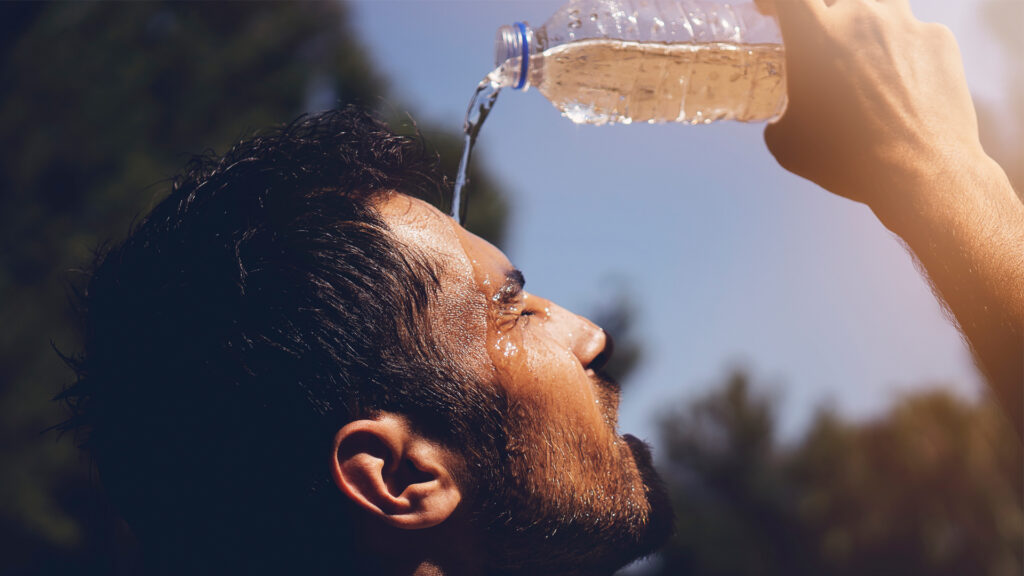By the Orlando Sentinel Editorial Board
At first, you sweat.
It’s the body’s first line of defense: Sweat, as it evaporates, can keep your body a critical degree or two cooler than the air around you. But a number of factors, including dehydration or tight-fitting, non-breathable clothing that traps sweat instead of letting it evaporate or intense physical activity that raises your core temperature faster than you can cool down, will defeat that defense. Another self-regulating system kicks in, and your breathing and pulse grow more rapid as your organs fight to lower your core temperature.
This is how the first signs of heat exhaustion feel — physical reactions that an increasing number of people experience every day. They are warnings that many don’t take seriously, and we’re not just talking about individuals. As global temperatures inch upward, Florida is obviously on the vanguard of a rising threat to life and health.
Yet local, state and national officials haven’t done nearly enough to combat the threat heat poses, and many Floridians will pay for that with their lives. That should change.
When your internal temperature crosses a critical threshold of 104 degrees, you’re in trouble. Your chances of recovery without medical intervention — by getting someplace cooler, by drinking water — start to dwindle.
The ranks of people at risk of heat-related health problems are wide and variable. Prolonged exposure to high temperatures can be particularly dangerous for young children and the elderly, as well as people who are pregnant, people with chronic diseases such as diabetes, people whose jobs keep them outdoors without ready access to shade or water, and athletes whose intense activity can push their temperature into the danger zone far more quickly. Risks also vary by location, with residents in densely populated urban areas suffering more than those in the suburbs and low-income people endangered because they can’t afford high electric bills.
But anyone can succumb to heat-related illness. As global temperatures inch upwards, more people will. That demands serious attention at the local, state and federal level.
Your skin is dry now, and flushed. You probably have a piercing headache and you may be feeling weak, dizzy, possibly nauseated. Your speech grows confused, your muscles are cramping and you may start to have convulsions or seizures. Inside, your body is at war with itself. Instead of slowing down, your metabolism will often speed up, pushing your temperature even higher.

The obvious place to start: Better education and warning. The National Weather Service already issues advisories in advance of anticipated spikes, as it did last week for South Florida, where it predicted “feels like” temperatures in the range of 105-111 degrees — clearly in the danger zone for most humans.
But those warnings might not reach those who need to hear them. Extreme heat advisories should follow the model set up for big, dangerous weather events such as hurricanes, including easy-to-decode levels of threat assessment, advisories on how and when people should protect themselves against dangerously high temperatures and other in-the-moment information that people need to make smart decisions.
Your liver, kidneys and brain start to shut down, then your blood vessels shred. You begin to hemorrhage, purple bruises blossoming across your skin. You are within minutes of becoming one of approximately 1,300 Americans who die each year of heat-related illness. With medical intervention, you may survive — but the chances of permanent brain damage or other long-term effects are significant.
For Floridians at the highest level of risk, warnings won’t be enough. There must be a level of infrastructure needed to deal with high heat. The CDC has suggested several ideas worthy of public investment, including the establishment of community cooling stations for those who don’t have access to air conditioning and urban forestry programs that can lower temperatures in intensely developed areas.
These are the easy solutions. Then it gets tough, because many of the needed changes fall into one of two areas.
The first: Economic support for those who cannot afford the energy required to stay cool. State and federal governments should consider subsidizing power costs for low-income households that kick in during hot months. But they should also investigate the potential of lower-cost solutions such as evaporative air conditioning units (also known as swamp coolers). These predate refrigerant-based air conditioning systems and require so little energy that many can be operated through USB connections.
The other required step: Restrictions on employers who might otherwise keep their workers in high-heat conditions with inadequate access to shade or water. This will cause Florida’s two biggest industries — agriculture and tourism — to scream bloody murder. Those protests should be viewed in this light: Would anyone dare to argue that companies had the right to force workers to cut ferns or sell theme-park balloons in the middle of a hurricane?
Some might still debate the causes of global warming. But its impact is undeniable. Most years, extreme heat already claims more lives than hurricanes, tornadoes, earthquakes, flooding and mudslides combined, and it’s only getting worse. Our leaders must come to grips with the need to take heat seriously, as the major health threat that it is, or more will die. And Florida will be among the first to bear the grim toll of that failure.
The Orlando Sentinel Editorial Board consists of Opinion Editor Krys Fluker, Editor-in-Chief Julie Anderson and Viewpoints Editor Jay Reddick.
This opinion piece was originally published by the Orlando Sentinel, which is a media partner of The Invading Sea. If you are interested in submitting an opinion piece to The Invading Sea, email Editor Nathan Crabbe at ncrabbe@fau.edu. Sign up for The Invading Sea newsletter by visiting here.



